
Nikon D800E w/ AF-S Nikkor 18-35mm f/3.5-4.5G ED
“Evening primroses look very well in the landscape of Fuji,” said Osamu Dazai in his popular novel Fugaku Hyakkei (100 views of Mt. Fuji). As I told in my previous post about the novel, Dazai didn’t actually see Fuji and evening primroses together in the same landscape. Some thoughtful people interpret this sentence as meaning that Dazai likened Fuji to the Japanese society and himself to evening primroses. When Dazai wrote this novel, Japan was governed by the military juggernaut. He was not conscripted into the army as he was physically as well as mentally fragile. I can imagine how he felt towards the society. It was a dark age in the history of Japan. There was no freedom. The military dictatorship severely controlled individuals. I think every creators and artists would hate such a government. Evening primroses don’t look spectacular at all. I thought they were just blooming weeds till recently. Honestly, speaking there are other flowers that look much better in the landscapes of Mt. Fuji. To name a few, cherry blossoms and cosmos flowers come to my mind.
The first picture was taken at Lake Shoji. It was a holiday. College students were rowing canoes and they contributed the view to look a little more peaceful. You park your car on the shore of Lake Shoji and set your tripods just next to your car. It is very easy to comfortably shoot beautiful landscapes if the weather is right. If your mobile carrier is AU, you can connect to the internet via 4G LTE. I often bring my Macbook Air and work with it while waiting for Fuji to show up.
 Nikon D800E w/ SIGMA ART 24-105mm f/4 DG OS HSM
Nikon D800E w/ SIGMA ART 24-105mm f/4 DG OS HSM
I took the shot above at Hana-no-Miyako Park located near Lake Yamanakako. It is a very nice place to shoot flowers with Mt. Fuji. There are always beautiful flowers in the park except for winter. The entrance fee changes from free to 500 yen depending on the season. It is free during winter, 300 yen in the early spring and late autumn, and 500 yen in the rest of the year. You need additional 300 yen per vehicle if you visit the place by car. I used the flashlight feature of my iPhone to lighten up the cosmos flower.  Nikon D600 w/ AF-S Nikkor 24-85mm f3.5-4.5G ED VR
Nikon D600 w/ AF-S Nikkor 24-85mm f3.5-4.5G ED VR
I found a field of cosmos flowers while I was driving my car in Oshino. Finding a good location for shooting Fuji is a lot of fun. Of course, you can just visit popular shooting locations and copy famous compositions but that isn’t very creative. I’m often perplexed when I’m asked to teach how to compose a photograph. Just shoot as you like! There are a lot of courses and books teaching how to compose photographs in Japan. I think it’s ridiculous. Why don’t you be yourself? Just shoot as many photographs as you can. Then, you’ll know how to compose your own photographs. Don’t try to be someone else.
When shooting flowers with an iconic mountain like Mt. Fuji, you might wonder which subject you should focus on. The following 4 patterns came to my mind:
1) Focus on a flower and defocus Mt. Fuji
2) Focus on Mt. Fuji (infinity) and defocus flowers
3) Place the focus point in between and narrow the aperture to the minimum
4) Take multiple shots by changing focus points, and then, blend them into one later in your PC to create a perfectly focused, sharp image (focus stacking)
I find myself choosing option 1) often. You can easily recognise the shape of Mt. Fuji even when it is defocused. But flowers kinda look mean when defocused. I mean if bokeh is huge, they may look artery but otherwise they often look mean. I sometimes choose option 3) too. But you need to note that , if you close the aperture to f/16 or higher, it causes a phenomenon called diffraction and it soften the image in an unfavourable way. When choosing this option, you usually have to make a decision whether or not to make both front and back objects in focus by degrading the image quality. Option 4 is a technique called focus stacking and often used in macro photography. But I rarely apply this technique in landscape photography with flowers because flowers usually sway in wind and don’t stay still. If the front object stays still (e.g. a stone statue,) this technique is worth trying. However, it is not easy to achieve perfectly sharp images if your lens has a focus breathing problem, that is, the actual focal length changes as you change the focus point even though you use the same focal length or a single focal-length lens.
Fuji usually gets her first snowcap when cosmos flowers are in bloom. It already snowed on the top but it melted away shortly after it snowed. In Japan, we call Fuji’s first snowcap ‘Hatsu-Kansetsu.’ It is not recorded as Hatsu-Kansetsu unless the snowcap can be clearly seen from Kofu Muroran Local Meteorological Observatory .
Note: Fuji got snowcapped on Oct 16 after I posted this article

Nikon D800E w/ AF-S Nikkor 14-24mm f/2.8G ED
I never noticed but some evening primroses are present at the left bottom of this ultra-wide angle shot I took in the Asagiri plateau. I wrote an article about this flower before. It made me smile because I liked the fact that I captured evening primroses and Fuji together unintentionally. Dazai said evening primroses look very well in the landscape of Mt. Fuji. But I’d say evening primroses look nice when they slip into the landscape of Mt. Fuji.